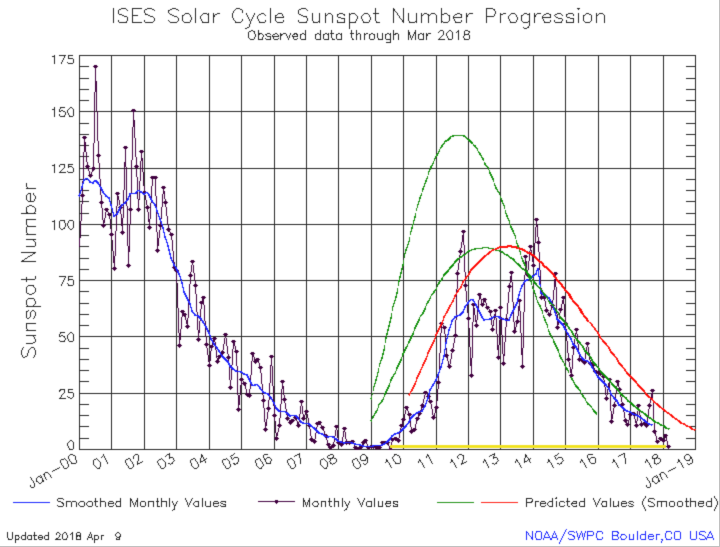
Caption
The Sun three years ago when storms were still visible on its surface. This image was taken by my friend Matt Francis, the director of the Prescott Observatory.
Subhead
Could a Deep Solar Minimum Bring About a New Ice Age?
More Like This
You talk as if the Earth itself is a star, and without Sun's periodic weakening the Earth would burn to a crisp. Without the Sun's influence the Earth would be a cold ball, despite all the talk of oven hot temperatures occurring if the climate continues to warm. Without the Sun warming the Earth, how hot do you surmise Earth would be? Probably not warm enough to heat your hands properly outdoors, since Earth produces only a small amount of it own heat. That heat radiates into the cold vacuum of space. We know there have been ice ages and interglacial periods in Earth's climate history. They occurred without the influence of humans or their tools. It's comical how many people think because we are here now, wear suits and ties, and have laptop computers, that we are going to put a stop to these cycles...rubbish. We may be able to control the climate if we controlled the energy output from the Sun, the Earth's Obliquity/ eccentricity, change the alignment of the planets, and other galactic occurrences, we could then talk about humans changing the climate. Humans have become fat, lazy, and arrogant. Unlike our ancestors that learned to adapt to the changing climate...oh no not us! We will foolishly think we can change it, without the ability to control the galactic forces I listed earlier. We here about the horrible amount of greenhouse gases from CO2-woe is me! However, when we examine green house gases we discover that only around 5% to 6 % of the atmosphere contains greenhouse gasses. Of that percentage only around 1% is CO2, most of it is water vapor. I guess that why it always listed as PPM, 600 PPM stresses the urgency more than 0.01. It seems to me that if a planet has no change in climate, it would be a dead planet.
The trend is your friend till the end. Your now at the end. Welcome to the Ice Age. Hope its just the little one and the the 11000 year plunge... Were off to a rough start. Looks like we just lost the citrus crop in Texas due to global cooling. Turns out once again the experts were fu#%king clueless at best, deceptive at worse. Turns out sunspot cycles or lack of them can influence temperatures of earth. Regardless of how much carbon is in the atmosphere. Now masses believe the climate is dangerously warming while in the real world parts are getting extremely cold. The entire fossil fuel complex has been kicked to the curb with infastructure not adapted to extreme cold in Texas on top of the windmills freezing fiasco. Some things I predict are about to change. Otherwise people will continue to freeze to death.
As a native American I see the planet cooling off. My vison in a near death experience.
We need to prepare for poor growing years. Use major hydroponic covered growing farms.
Use our supply f natural gas for heating the sites
The harmonic sinusoidal models by NOAA NASA are vague with poor accuracy of past cycles like other climate models.
Cycle 25 will be the weakest in recorded history.
Based on our ARIMA sunspot cycle model I predict this 21st Century Grand Solar Minimum to be comparable to the 17th Century Maunder minimum cycle of 1645 - 1715 and lot worse than the 18th Century Dalton Minimum cycle of 1790 - 1830, the 19th Century Glassberg Minimum cycle of 1880 - 1914, and the 20th century Modern Minimum cycle of 1914 - 2007.
The longer duration 21st Century Grand Solar Minimum Sunspot Cyclic ARIMA Model (11,1,0) (11,1,12) predicts the Annual Total Sunspots, as follows:
2018: 104 (measured 85)
2019: 30 (measured 42)
2020: 68
2030: 74
2040: 20
2050: 0
Consequences: Less active Sun, more Cosmic Rdiation penetration to troposphere, more cloud seeding, less incident Sola radiation, temperature drop, more cooling worldwide, less rainfall, crop failures and droughts, diseases, electricity grid disasters due to UN led campaign of weather dependent wind and solar energy.
Poor people and developing countries will suffer the most.
While irrepairable damage to natural climate change cycles is being caused by the UN led agenda of CO2 tax to stop ClimateChange and current efforts to contaminant skies for solar radiation management and climate intervention.
@drwaheeduddin
"Cycle 25 will be the weakest in recorded history"
How has that turned out for you? When will you be making your retraction?
I firmly believe that scientists should ignore the "Social Sciences" and stick to facts. There is nothing more egregious to me than "corrected" research facts. Collect data in the most accurate method that you can and simply allow others to formulate conclusions, as they will. I am not an expert on climate or the sun, however I am an avid student of history. I believe that there is a convincing possibility that human beings are not nearly as influential on this planet as some would have us believe. If there is likely to be a great influencer on this planets climate and weather, I find it more highly probable that it is the sun. We are not driving this bus, we are merely along for the ride. I think it is the apex of hubris to believe that we can impact this world in any manner that approaches the magnitude of what the sun, the moon and even the internal cycles of the very planet we reside on have. All of that being said, I do not suggest that we spoil the environment. We owe it to ourselves and out fellow creatures on this planet to husband the environment as best we can while doing our best to survive with the most prosperity that we can do that one day we can improve our species survival chances. In the meantime, try to educate those reasonable folks around you to prepare for the worst and hope for the best. I believe that is the best we can do.
The solar cycles start with a fairly consistent low value for sunspots to a varied high. It makes more sense to consider them as starting at the low, as the impact of sunspots on temperature is similar at that time. Tracking the temperatures during the minimum years is one way of seeing the steady increase in global temperatures.
The maunder minimum lasted for several cycles so there is no evidence yet that we are in such a period. There has been some recent research suggesting that multiple cycles are embedded within the major cycles that could cause the next few cycles to be low. However we will have to wait a few decades to see how that plays out.
What we have seen is that sunspots do raise temperatures on earth compared to the background level of no sunspots. The difference between a maximum and minimum appears to be about 0.3 degrees however in this weak cycle that may be reduced to just half that. The absence of sunspots does not cause cooling and the effect of the minimums compared with the underlying warming caused by CO2 increases is insignificant.
Currently we are at a solar minimum with no El Nino influence, yet this years global temperature appears likely to be second hottest on record. Any suggestion that a maunder minimum would reduce temperatures over the next few decades is pure disinformation created by those who wish to sidetrack the discussion on rising temperatures.
Can someone please give us the facts? If we're in a solar minimum when did it start (year and mo. please) and when will it end (year and mo. please). Are we in a "Maunder" Minimum that a few links have hinted at on the internet. Again, nobody is speaking with one tongue (together on the facts) but we have one site saying one thing and another site saying something else. I haven't heard NASA's take on these questions either. So, we're either in one or we're not, it's we're entering a Maunder Minimum or we're not. Which one of these is it, please?
I noticed one thing not discussed by the commenters. The major earthquakes and volcanic eruptions that tend to be a part of the Grand Solar Minimum. If the New Madrid Fault ruptures with an 7.5 to 9.0 Magnitude quake it would split the US in two. Most of the natural gas and oil from Texas and Oklahoma goes through pipelines that cross the New Madrid Fault to get to the Eastern US. The last time it ruptured was in the winter of 1811-1812. It created a new series of lakes and made the Mississippi River run Northward for 3 days. There was also a major volcanic eruption of Tambora. 100 times as powerful as Mt. Saint Helens. This actually lowered global temperatures by as much as 2-3 degrees F. For more details about dangers where you live read John L. Casey's book "Upheaval" published in December 2016.
- « Previous
- 1
- 2
- …
- 10
- Next »










Comments